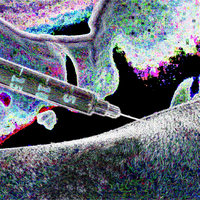| Diprophylline | |
|---|---|
| Molecular structure via molpic based on CDK |
| Physical properties [] | |
|---|---|
| Molecular mass | 254.24 g/mol [1] |
| Appearance | CRYSTALS FROM ALCOHOL [1] |
| Taste | EXTREME BITTER TASTE [1] |
| Melting point | 155-157 [1] |
| Solubility | >38.1 [ug/mL] (The mean of the results at pH 7.4) [1] |
| Predicted LogP | -1.8 [1] |
| Structural Identifiers [] | |
|---|---|
| Molecular formula | C10H14N4O4 [1] |
| IUPAC name | 7-(2,3-dihydroxypropyl)-1,3-dimethylpurine-2,6-dione [1] |
| SMILES | CN1C2=C(C(=O)N(C1=O)C)N(C=N2)CC(CO)O [1] |
| InChI | InChI=1S/C10H14N4O4/c1-12-8-7(9(17)13(2)10(12)18)14(5-11-8)3-6(16)4-15/h5-6,15-16H,3-4H2,1-2H3 [1] |
| InChIKey | KSCFJBIXMNOVSH-UHFFFAOYSA-N [1] |
Diprophylline
Diprophylline (also known as dyphylline, Diphylline, 7-(2,3-Dihydroxypropyl)theophylline, Diprophyllin, Glyphylline, Protheophylline, Aristophyllin, Corphyllin, Diprofillin or Diprofilline) is a
Chemistry
Stereochemistry []
(RS)-Diprophylline is a racemic mixture of the optical stereoisomers
Legal status
- United States: Diprophylline is a prescription only substance.
See also []
External links []
- Diprophylline (Wikipedia)
- Diprophylline / (+)-Diprophylline (Wikidata)
- Diprophylline (DrugBank)
- Diprophylline / (+)-Diprophylline (PubChem)
- Diprophylline (ChEMBL)
- Diprophylline / (+)-Diprophylline (ChEBI)
- Diprophylline / (+)-Diprophylline (Common Chemistry)
- Diprophylline (HMDB)
- Diprophylline (KEGG)
- Diprophylline / (+)-Diprophylline (UNII)
- Diprophylline / (+)-Diprophylline (EPA DSSTox)
References []
National Center for Biotechnology Information. PubChem Compound Summary for CID 3182, Diprophylline. Accessed June 26, 2025. https://pubchem.ncbi.nlm.nih.gov/compound/3182
U.S. Food and Drug Administration; National Center for Advancing Translational Sciences. Diprophylline. UNII: 263T0E9RR9. Global Substance Registration System. Accessed June 26, 2025. https://gsrs.ncats.nih.gov/ginas/app/beta/substances/263T0E9RR9
 Anodyne
Anodyne